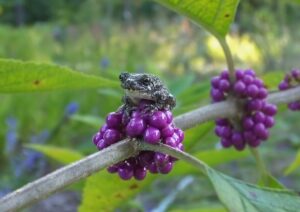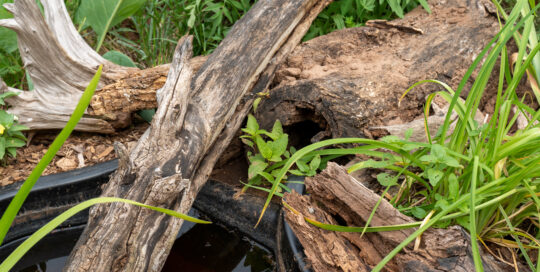A southern delight for wildlife: American Beautyberry
Views: 460

I’m lucky enough to live in a zone that supports American Beautyberry (Callicarpa americana). This southern shrub can be an excellent choice for supporting local biodiversity. I’ll never forget walking a formal garden near Charleston, South Carolina, marveling at how beautyberry was used in the borders of so many varied spaces. With fall arriving soon, it’s the perfect time to incorporate it into your own landscape. It grows quickly, and in a single year, you may enjoy some berries a year from now.
Native Range
American Beautyberry is native to the southeastern United States. It’s commonly found in states such as Florida, Georgia, Alabama, Mississippi, Louisiana, and Texas, among others. Beautyberry is hardy in USDA zones 7 to 11 but may overwinter in zone 6 in protected locations. My bushes have survived some brutally cold winters recently.
Why American Beautyberry for Wildlife
Beautyberry is excellent for wildlife. Here’s why:
- Berries for Birds: American Beautyberry is renowned for its stunning clusters of bright purple berries that appear in the fall. These berries are a vital food source for a variety of bird species, including mockingbirds, cardinals, robins, and other songbirds. By providing these berries, you can attract local bird populations.
- Habitat and Nesting: Beyond its edible berries, American Beautyberry also offers shelter and nesting sites for birds and small wildlife. Its dense, arching branches with broad leaves create a suitable habitat for animals seeking cover and protection. This makes it a valuable addition to your garden, especially if you want to encourage nesting and provide refuge for wildlife.
- Drought Tolerance: American Beautyberry is relatively drought-tolerant once established, making it a hardy and low-maintenance choice for your garden. I admit, I have to water mine during hot, dry, Oklahoma summers, but they do survive these extremes.
How to Plant American Beautyberry
Here’s a step-by-step guide on how to plant American Beautyberry in your garden:
- Choose the Right Location: These shrubs thrive in well-drained soil and prefer partial to full sunlight. Select a location that receives at least 4-6 hours of sunlight per day.
- Prepare the Soil: Ensure that the soil is well-drained and has good organic content. If your soil is heavy or compacted, consider amending it with organic matter like compost to improve drainage and fertility.
- Planting: Dig a hole roughly the same depth as the root ball but twice as wide. Place the American Beautyberry plant in the hole and backfill it with soil. Water thoroughly after planting to help settle the soil around the roots.
- Spacing: Space multiple American Beautyberry plants at least 3-5 feet apart to allow for their mature size, as they can grow into a shrub that’s 3-8 feet in height and width.
- Mulch: Apply a layer of mulch around the base of the plant to help retain moisture, regulate soil temperature, and suppress weeds.
- Watering: Water the plant regularly, especially during its initial establishment period. Once established, American Beautyberry is relatively drought-tolerant and will require less frequent watering.
- Pruning: Prune American Beautyberry in late winter or early spring to remove dead or weak branches and to maintain its shape.
By following these planting and care guidelines, you can create an inviting and wildlife-friendly garden with American Beautyberry as a valuable contributor. Over time, you’ll likely witness an increase in bird activity and other wildlife visitors enjoying the beauty and benefits of this native shrub.
Featured image photo by Peter Rea/USFWS (public domain).
Meet Leslie Miller
Leslie Ann Miller shares 3.5 acres in rural Oklahoma with birds, butterflies and wide variety of animals. She is currently transforming her yard with plantings…
Leslie's Recent Posts

Creating microclimates and microhabitats to benefit wildlife






